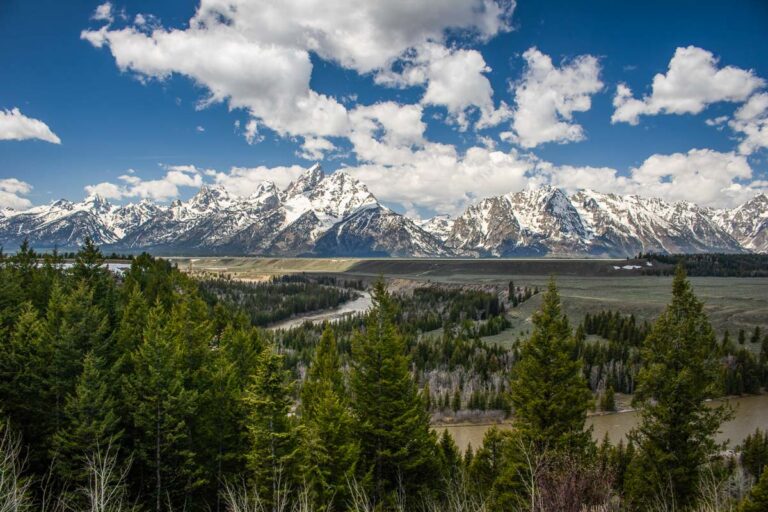10 Amazing Wildlife Conservation Success Stories in the National Parks
Besides spectacular canyons, mighty mountains, towering forests and stunning lakes, America’s national parks are also world-famous for their abundant wildlife.
In fact, many people visit the parks specifically to see iconic animals in the wild. In this post, we’ll explore some of the greatest wildlife conservation success stories in the national parks.
While there are (still) lots of beautiful, fascinating, imposing and even dangerous animals in the parks, many of the most famous species survived because of the national parks and the protection they offer(ed).
Amazing Wildlife Conservation Success Stories in the National Parks
Established to preserve landscapes and the things living in them, while also providing educational and recreational opportunities to visitors, the national parks’ dual mandate can make park management a challenging balancing act.
With all their flaws and riches, the national parks have one unique feature: they offer wild animals perpetual protection against hunters, urban development and (as far as possible nowadays) pollution.
As they disappear elsewhere in the country, many animals find refuge in the National Park System.
Several of the most amazing national parks wildlife conservation success stories involve some of America’s most iconic animals.
This includes bald eagles, turkeys and alligators, wolves and bison. All came dangerously close to extinction, only to be saved by open spaces, wildlife management and, simply put, opportunity for survival in the national parks.
Let’s take a closer look at the greatest success stories of wildlife conservation in America’s national parks.
(I used the IUCN Red List of Threatened Species to determine the conservation status mentioned for each species, which is current as of April 2021.)
10. Wild Turkeys

Certainly one of the best-known birds in America, wild turkeys (Meleagris gallopavo) are one of only two New World bird species that have ever been domesticated.
The descendants of these wild turkeys are now a staple of numerous Thanksgiving feasts and over 200 million turkeys are raised on American farms each year.
Wild turkeys are such an iconic American species “Benjamin Franklin would have preferred to have the wild turkey, not the bald eagle, chosen as the national symbol of the United States”, according to Audubon.
So, they may seem like a strange animals to include in a list about wildlife conservation success stories. However, there weren’t always as many turkey as there are now.
By the early-20th century, their popularity as a food source had pushed them to near-extinction throughout the United States.
Now, however, wild turkeys really are a success of wildlife conservation, widespread and plentiful all over the United States. Once again, they are found in every state except for Alaska.
In fact, they’re one of the most widespread national park birds now! You can find wild turkeys everywhere from Zion and Mesa Verde to Rocky Mountain, Shenandoah and Everglades.
Wild Turkey Conservation Status
Least concern (population increasing)
Best National Parks to See Wild Turkeys
- Acadia National Park, Maine
- Everglades National Park, Florida
- Mesa Verde National Park, Colorado
- Shenandoah National Park, Virginia
- Zion National Park, Utah
9. Nēnē

Of all nine species of goose that evolved on the Hawaiian Islands, the nēnē (Branta sandvicensis) is the only remaining native goose in Hawaii today. Once upon a time, thousands upon thousands of nēnēs called the islands home, but by the 1940s, there were merely 50 of them left.
Decades of habitat loss, hunting and predators by non-native animals like dogs and cats brought Hawaii’s nēnē population perilously close to extinction.
Now, although those predators are still a threat, conservation and breeding programs in parks like Hawai’i Volcanoes National Park and Haleakalā National Park have restored the population to healthy levels again.
There are a significant number of nēnēs in both Hawaiian national parks, but close monitoring and provision of safe spaces for these wonderful birds remains necessary.
Nēnē Conservation Status
Near threatened (population increasing)
Best National Parks to See Nēnē
- Haleakalā National Park, Maui, Hawaii
- Hawai’i Volcanoes National Park, Big Island, Hawaii
8. Trumpeter Swans
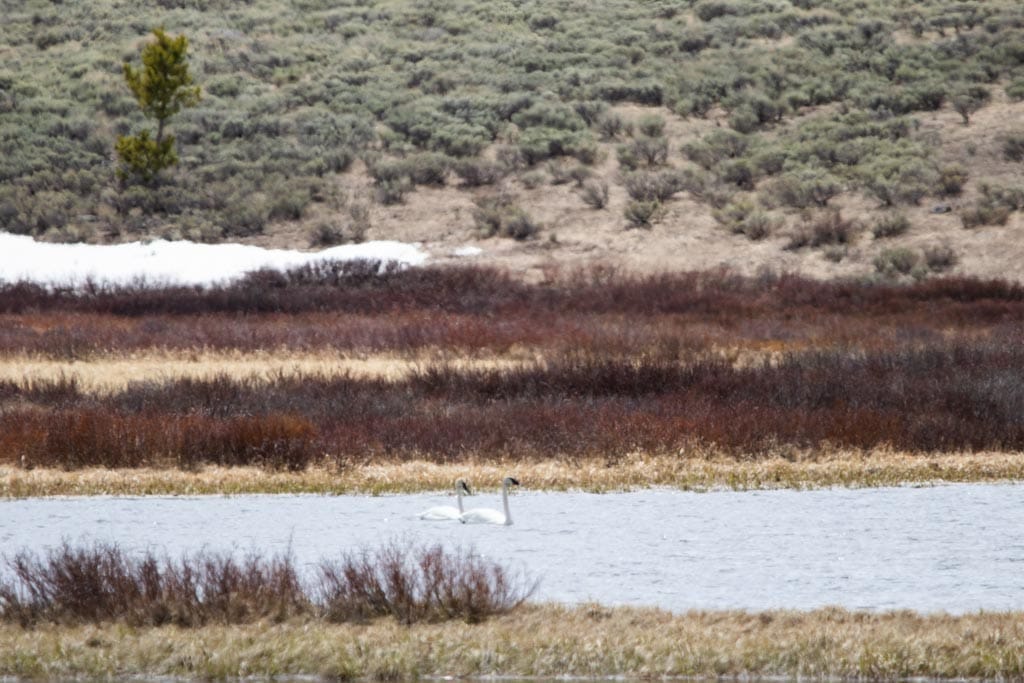
Once abundant all over North America, trumpeter swans (Cygnus buccinator) almost went extinct in the early-20th century. Because of overhunting and the westward advance of civilization in America, there were fewer than 100 trumpeter swans left in the contiguous United States by the 1930s.
Nowadays, there are relatively large populations of trumpeter swans in the Pacific Northwest and Alaska, as well as in pockets throughout the northern Rockies and around the Great Lakes.
The rebound of the trumpeter swans is considered yet another amazing success of the 20th-century conservationist movement in America.
These beautiful, elegant white birds are North America’s largest waterfowl. They live in and around large rivers, lakes and ponds, preferring shallow, still or slow-moving, water with plenty of vegetation.
Trumpeter Swan Conservation Status
Least concern (population increasing)
Best National Parks to See Trumpeter Swans
- Denali National Park, Alaska
- Grand Teton National Park, Wyoming
- Olympic National Park, Washington
- Yellowstone National Park, Wyoming, Montana and Idaho
- Wrangell-St. Elias National Park, Alaska
7. Peregrine Falcons
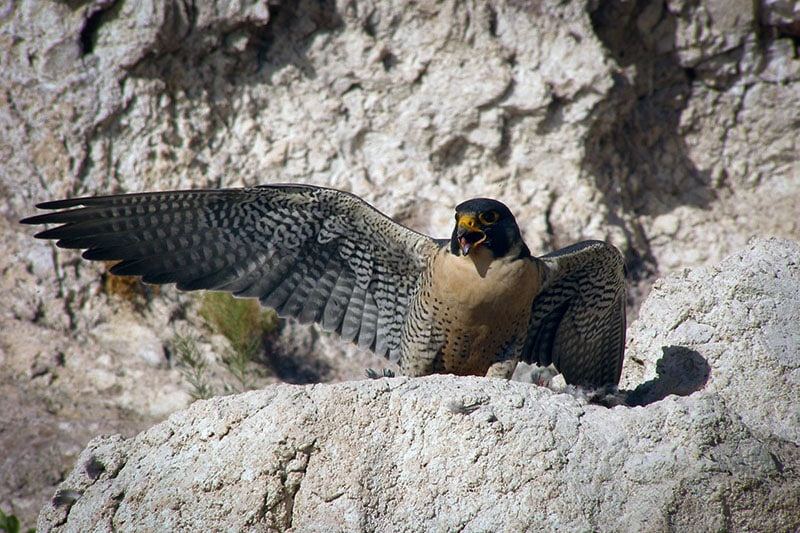
Considered one of the world’s most spectacular birds by many ornithologists and biologists, peregrine falcons (Falco peregrinus) are the fastest animal on Earth. They can reach dizzying speeds of up to 200 miles per hour.
Peregrine falcons are the fighter jets of the avian world, power-diving from incredibly high and striking prey so hard they’re literally knocked out of the sky.
This beautiful white and blue-gray bird of prey is found on all continents except Antarctica, making it one of the world’s most widespread birds.
Yet, in many areas, it came perilously close to extinction in the mid-1900s due to the effects of pesticides, most notably DDT.
Nowadays, many U.S. national parks have peregrine falcons protection programs, which often include temporary trail closures during the birds’ breeding season.
One of the most beautiful and amazing national park birds, peregrine falcons nest on cliffs, in tall trees or on hilltops.
They live all across the United States, but are most common along the coasts, in the Rocky Mountains and the Southwest canyons.
Peregine Falcon Conservation Status
Least concern (population increasing)
Best National Parks to See Peregrine Falcons
- Acadia National Park, Maine
- Arches National Park, Utah
- Big Bend National Park, Texas
- Crater Lake National Park, Oregon
- Grand Canyon National Park, Arizona
- Guadalupe Mountains National Park, Texas
- Olympic National Park, Washington
- Shenandoah National Park, Virginia
- Zion National Park, Utah
6. American Alligators
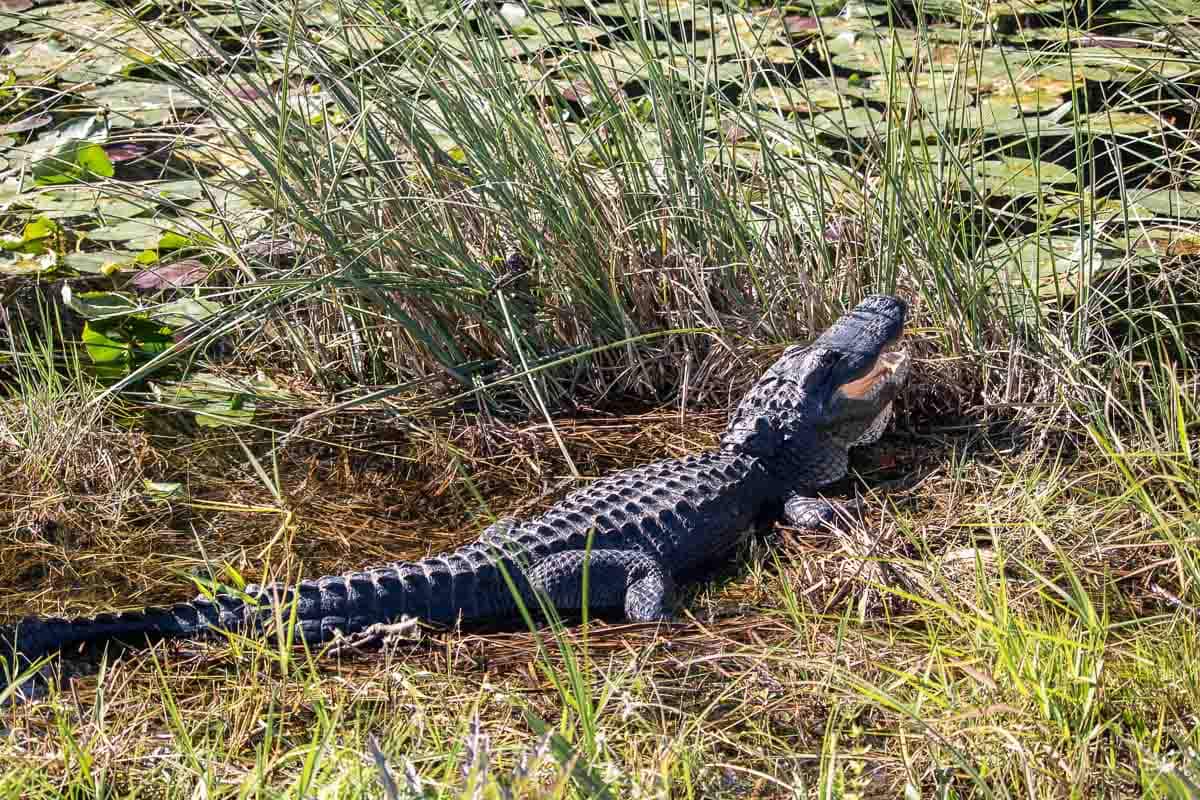
An important keystone species in the southeastern United States, American alligators (Alligator mississippiensis) are an apex predator, but also affect their environment in less obvious ways.
For example, they dig mud burrows with their powerful tails, but when they leave their nests, the hole fills up with freshwater, which in turn provides drinking and breeding opportunities for numerous other species.
So, it’s no surprise that the conservation movement in the United States was alarmed by significantly decreasing alligator populations in the early-20th century.
Although these iconic animals have been around for 200 million years, they came very close to extinction in the mid-1900s. This population decrease was the result of habitat destruction for urban development, as well as overhunting for trade.
American alligators were put on the endangered species list in 1967, after which wildlife agencies set up captive breeding programs. In addition to the implementation of hunting regulations, these successful programs effectively saved the species.
In fact, the population of American alligators in the southeastern USA increase so dramatically they were taken off the list in 1987, only 20 years after they were put on it.
Nowadays, there are about 5 million American alligators in the wild and it’s, once again, a species of “least concern.”
American Alligator Conservation Status
Least concern (population increasing)
Best National Parks to See American Alligators
- Biscayne National Park, Florida
- Congaree National Park, South Carolina
- Everglades National Park, Florida
5. Gray Wolves
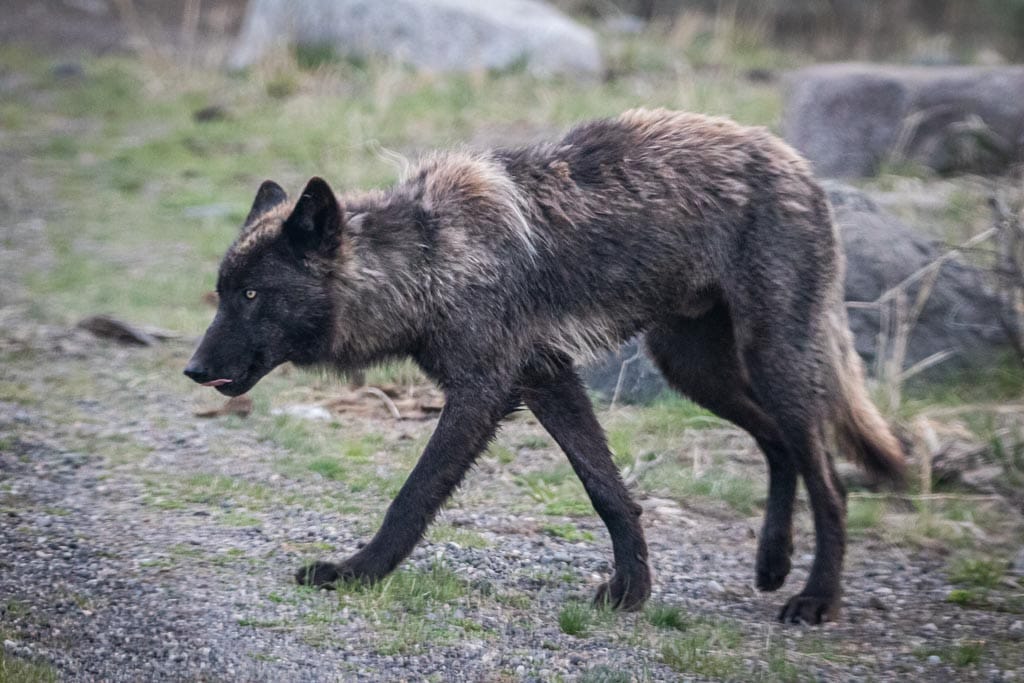
Once one of North America’s most successful land mammals, gray wolves (Canis lupus) are now gone from over 90% of their historical range in the continental United States. In only a couple of centuries, their numbers dwindled from a couple of million to just a few thousand.
One researcher famously called it “the most relentless and ruthless persecution one species has ever waged against another.”
By the 1960s, only about 300 wolves survived in the wild in the remote woods of Minnesota and Wisconsin. Their subsequent listing as a federal endangered species in 1970 literally saved them from extinction in the United States.
Nowadays, however, regulations have become less strict and wolf hunting is (either still or again) allowed in many states where they’re found.
America’s gray wolves remain very vulnerable and are a front-line species in an ongoing wildlife conservation battle in and around the national parks.
They’re not only a key species in the natural food chain, but also serve as a key subject in often-heated political debates.
Once again—just like they saved the other wild animals in this list—it’s the national parks that offer a refuge to wild gray wolves, one of America’s greatest wilderness icons.
The parks provide space for them to roam freely and live undisturbed lives, while being monitored by conservationists, biologists and other researchers.
The gray wolf’s survival in U.S. national parks is yet another illustration of the sheer importance of these protected lands. Without them, there might not have been a single wild wolf left in the lower 48 states by now.
Gray Wolf Conservation Status
Least concern (population stable)
Best National Parks to See Gray Wolves
- Denali National Park, Alaska
- Grand Teton National Park, Wyoming
- Isle Royale National Park, Michigan
- Katmai National Park, Alaska
- Voyageurs National Park, Minnesota
- Yellowstone National Park, Wyoming, Montana and Idaho
4. Black-Footed Ferrets
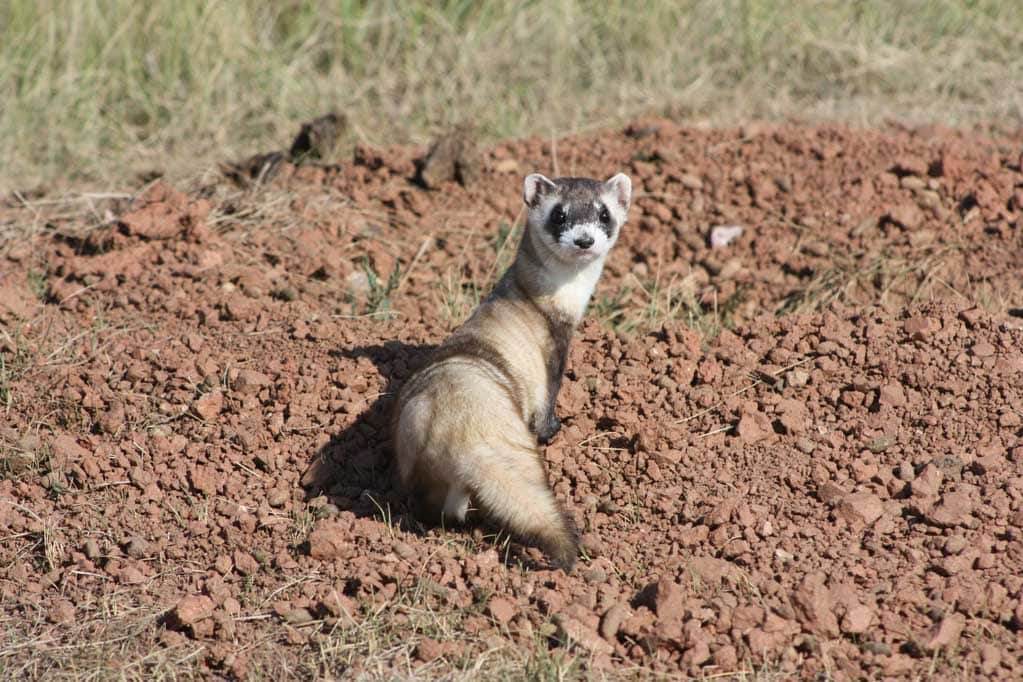
At their most imperiled time, black-footed ferrets (Mustela nigripes) were among the rarest mammal species in the world. Members of the weasel family, these amazing animals are almost entirely dependent on healthy prairie dog populations for their food and, as such, survival.
However, because of both habitat loss due to agricultural expansion and extermination practices by humans, prairie dog populations plummeted in certain parts of the United States.
The black-footed ferrets, which happened to live in exactly those regions, were almost wiped out entirely.
The U.S. government recognized the animals as endangered in 1967. After the implementation of the Endangered Species Act in 1973, they were immediately added to the list. Things still got worse, though.
Scientists even considered the species extinct until a ranch dog in Wyoming killed a wild black-footed ferret and a small hidden population was discovered. However, that population—as if the species hadn’t struggled enough—suffered from disease.
The situation grew so dire that, by 1987, there were only 18 black-footed ferrets of that population left in the wild—and none in captivity.
So, in a last effort to save the species, all remaining 18 animals were captured and put into a breeding program. In 1994, the National Park Service reintroduced the first group of ferrets in Badlands National Park, followed by another reintroduction in Wind Cave National Park in 2007.
Nowadays, approximately 200 to 300 black-footed ferrets live in the American wild.
This is yet another amazing wildlife conservation success story in the national parks, even though the fight is far, far from over. They are still one of the most endangered animals in North America.
Black-Footed Ferret Conservation Status
Endangered (population decreasing)
Best National Parks to See Black-Footed Ferrets
- Badlands National Park, South Dakota
- Wind Cave National Park, South Dakota
3. Bald Eagles

The most iconic bird in America, the majestic bald eagle (Haliaeetus leucocephalus) is a symbol and emblem of the nation. With its massive talons, sharp beak, huge wings and distinct white head, this bird is literally a force of nature.
Nowadays, bald eagles live all over the United States, but they are more abundant near water where there are plenty of food sources. This includes river valleys, coasts, lakes and wetlands.
They’re particularly common along the Mississippi River, in southern Florida, the Great Lakes, the Oregon-California border region, and the coasts of the Pacific Northwest, Alaska and Maine.
However, as abundant as they are today, they were literally on the brink of extinction in the 1960s in their entire range.
Similar to the peregrine falcons above, bald eagle suffered tremendously from a huge reduction in prey species, as well as the effects of the egg-thinning pesticide DDT.
The bald eagle was included in the original endangered species list in 1967, while the EPA banned DDT half a decade later, in 1972. Its status as an endangered species gave the bald eagle important protections, including from habitat loss and hunting.
Additionally, captive breeding programs and reintroduction efforts allowed this majestic bird species to fully recover. They are no longer endangered.
Bald Eagle Conservation Status
Least concern (population increasing)
Best National Parks to See Bald Eagles
- Acadia National Park, Maine
- Congaree National Park, South Carolina
- Everglades National Park, Florida
- Glacier National Park, Montana
- Glacier Bay National Park, Alaska
- Isle Royale National Park, Michigan
- Katmai National Park, Alaska
- Kenai Fjords National Park, Alaska
- Olympic National Park, Washington
- Redwood National Park, California
- Voyageurs National Park, Minnesota
- Yellowstone National Park, Wyoming, Montana and Idaho
2. California Condors

In the mid-1980s, after decades of poisoning, poaching and habitat loss, fewer than 30 California condors (Gymnogyps californianus) existed in the wild.
So, to save the species from extinction, all remaining birds were captured for a remarkable breeding program. (The species was officially extinct in the wild in 1987, but that was because all remaining wild condors were caught.)
Thanks to the success of that breeding program, several captive-bred California condors have been released into the wild. Now, there are over 450 wild California condors.
While this proves the amazing merit and potential of wildlife conservation, these condors are still one of the rarest bird species in the world. They continue to be monitored intensively.
This mighty and magnificent bird—the largest land bird in North America—can now be seen soaring through the skies in a few locations in California, especially in Pinnacles National Park and, since recently, in the Redwood National and State Parks.
You can also see them in and around the Grand Canyon and Zion National Park.
As far as national park bird conservation goes, it doesn’t get much better than the story of the California condor.
California Condor Conservation Status
Critically endangered (population increasing)
Best National Parks to See California Condors
- Grand Canyon National Park, Arizona
- Pinnacles National Park, California
- Redwood National Park, California
- Zion National Park, Utah
1. American Bison
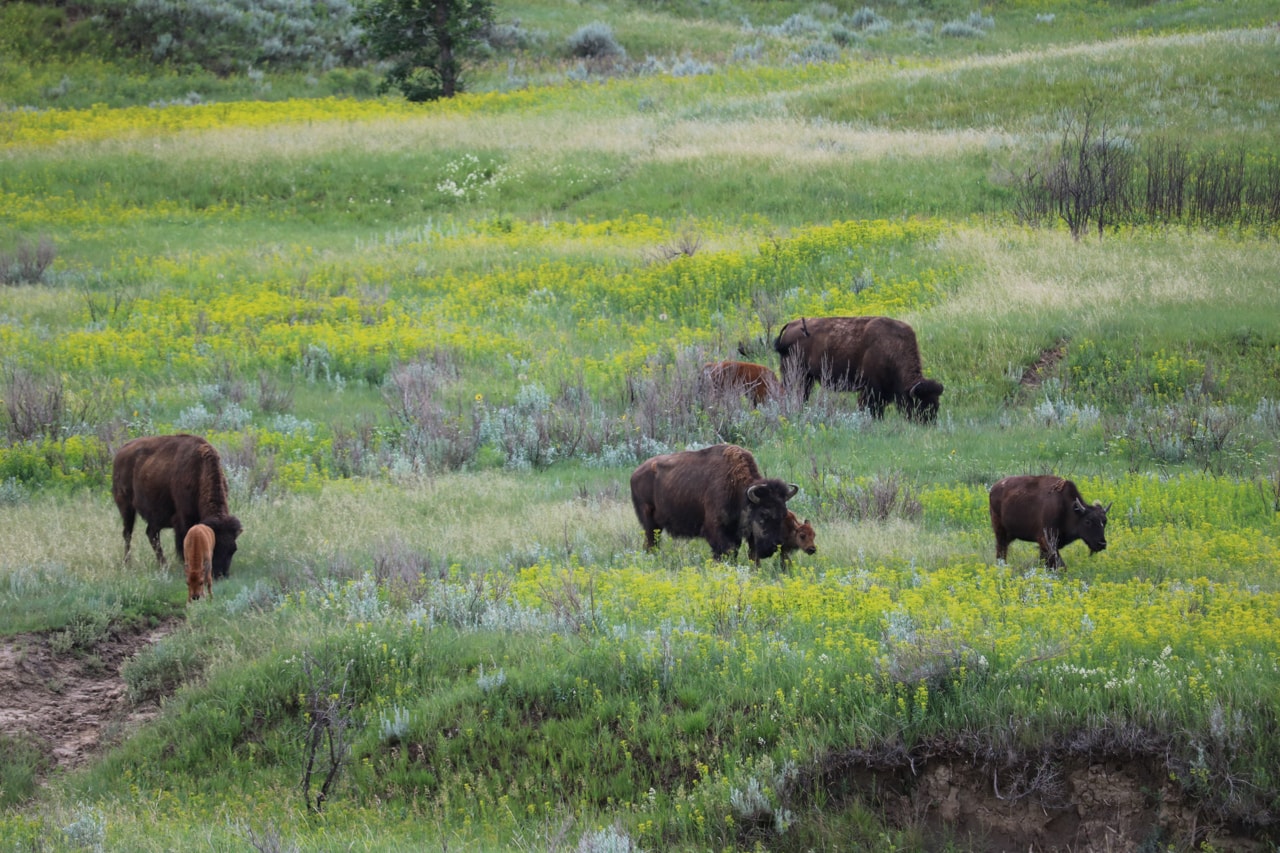
For hundreds of thousands of years, American bison (Bison bison), often also (wrongly) called buffalo, roamed the Great Plains in truly massive numbers—estimates go as high as 30 to 60 million. Then, European settlers arrived.
By the end of the 19th century, after just a few decades of mass slaughter, fewer than 1,000 wild bison remained.
The World Wildlife Fund doesn’t leave any doubts about how bad this actually was: “No other species on Earth has declined so fast.”
Now, after dedicated conservation efforts, including in national parks like Yellowstone, Grand Teton, Badlands, Wind Cave and Theodore Roosevelt, there are once again many thousands of wild bison in America, one of the most iconic national park mammals.
However, the plains bison conservation status is still “near threatened.” They’re not out of the woods yet, so to speak.
Nowadays, the American Plains are home to 17 federally managed bison herds. About 20,000 plains bison are managed as wildlife.
Only 5,000 of them, however, are actually disease-free and unfenced. Most of those live in Yellowstone National Park, which is the only place in the U.S. where bison have lived continuously since prehistoric times.
While it’s difficult to pick the most important of the many major national parks wildlife conservation success stories, the story of the bison is arguably the greatest.
American Bison Conservation Status
Near threatened (population stable)
Best National Parks to See American Bison
- Badlands National Park, South Dakota
- Grand Teton National Park, Wyoming
- Theodore Roosevelt National Park, North Dakota
- Wind Cave National Park, South Dakota
- Yellowstone National Park, Wyoming, Montana and Idaho



